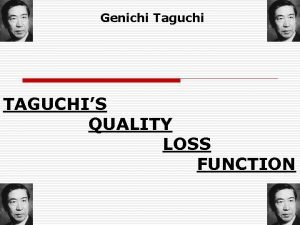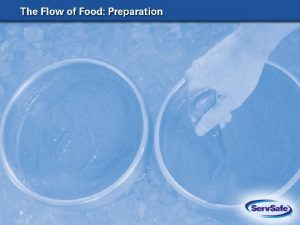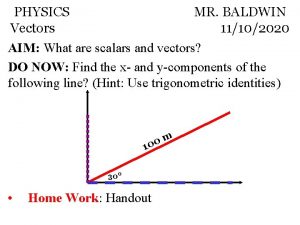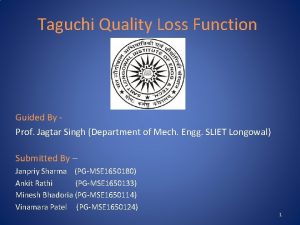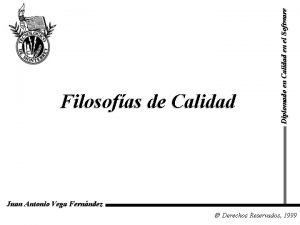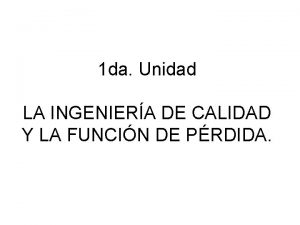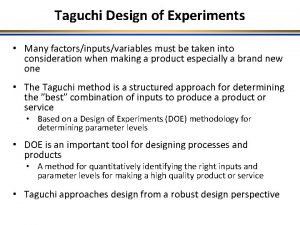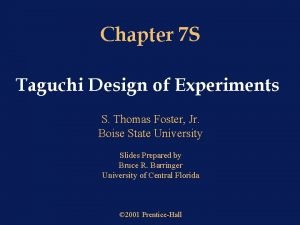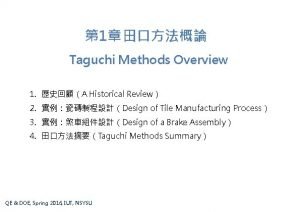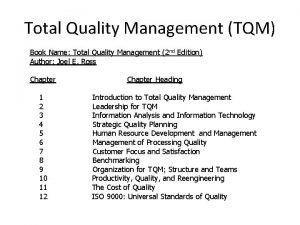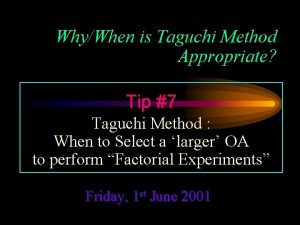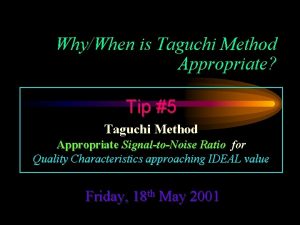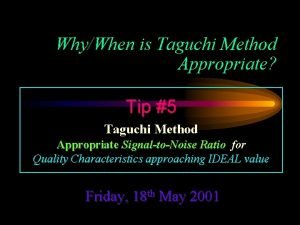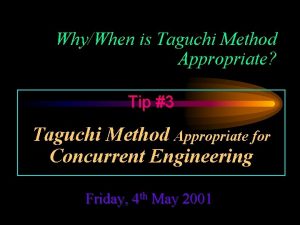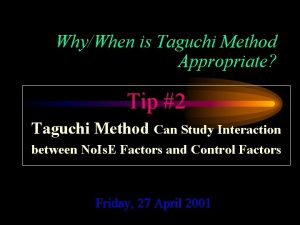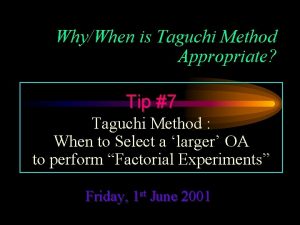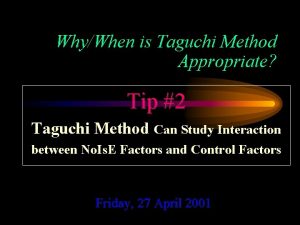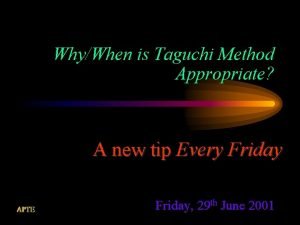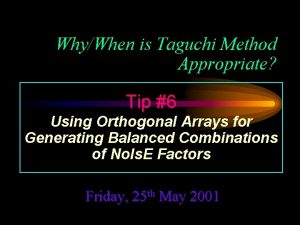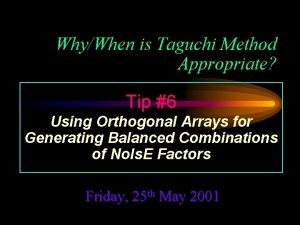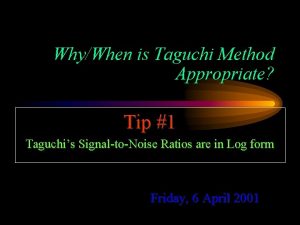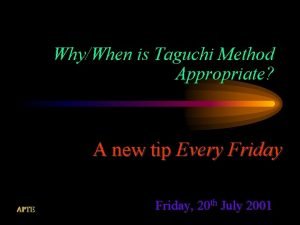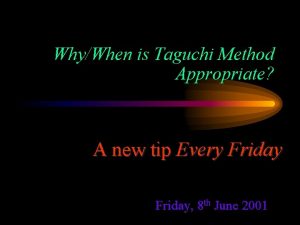WhyWhen is Taguchi Method Appropriate Tip 3 Taguchi














- Slides: 14

Why/When is Taguchi Method Appropriate? Tip #3 Taguchi Method Appropriate for Concurrent Engineering Friday, 4 th May 2001

Tip #3 Taguchi Method Appropriate for Concurrent Engineering (next 7 slides) Friday, 4 th May 2001

Taguchi Method P-Diagram with Internal/External noises Noise Factors X INTERNAL NOISE EXTERNAL NOISES Process / Product Diagram Y Z Control Factors Friday, 4 th May 2001

Taguchi Method Effect of Internal/External noise on the output Y Noise Factors X EXTERNAL NOISES Process / Product Diagram Y VARIATIONS INTERNAL NOISE Z Control Factors Friday, 4 th May 2001

Taguchi Method : Coupling 2 Process Stages • Variation in output of Stage #1 acts as NOISE input to Stage #2 • STAGE #1 itself is made insensitive to all noises, so that variations in its output Y 1 are minimum • STAGE #2 is made insensitive to variations in output of Stage #1 Process / Product Stage #1 Y 1 VARIATIONS Process / Product Stage #2 Z Z Control Factors Y 2 VARIATIONS

Taguchi Method Effect of Coupling 2 Process Stages on the output Y 2 Noise Factors X X EXTERNAL NOISES Process / Product Stage #1 INTERNAL NOISE EXTERNAL NOISES Y 1 VARIATIONS Process / Product Stage #2 INTERNAL NOISE Z Z Control Factors Y 2 VARIATIONS

Taguchi Method : Coupling 2 ROBUST Process Stages • STAGE #1 DESIGN OBJECTIVE : • Achieve insensitivity to all noises => min. variations in its output Y 1 • Determine “adjustment factor” => to adjust level of Y 1 • STAGE #2 DESIGN OBJECTIVE : • Achieve insensitivity to all noises including variations in Y 1 => min. variations in its output Y 2 • Determine “adjustment factor” => to adjust level of Y 2 • Determination of an “adjustment factor at each stage” • allows easy adjustment of output levels at a later time, say during integration of stages, without affecting variations

IMPORTANT • Main purpose of conducting matrix experiments (using Orthogonal Arrays) – to achieve insensitivity to noise by determining the best settings of control factors – to identify the ‘adjustment factor’ • This is achieved by Taguchi’s 2 -Steps – First step minimize variance – Second step to ‘adjust’ the mean-on-target

More Tips 16. Links below Taguchi Method e 1 st Priority : Va ia ce R duction 2 nd Priority : Factor Effects Friday, 3 rd Aug 2001 15. “inner” L 9 array with “outer” L 4 and L 9 No. Is. E arrays Friday, 27 th July 2001 14. Taguchi Method r n “inner” L 18 array with “outer” L 4 and L 9 No. Is. E arrays 13. Friday, 20 th July 2001 Taguchi Method Why/When is Taguchi Method not Appropriate? Friday, 13 th July 2001 Tips 12, 11, 10

More Tips 12. Taguchi Method Links below Friday, 6 th July 2001 “inner” L 8 array with “outer” L 4 and L 9 No. Is. E arrays 11. Taguchi Method Friday, 29 th June 2001 Useful at ALL Life-stages of a Process or Product 10. Taguchi Method Friday, 22 nd June 2001 Performs Process “centering” or “fine tuning” Tips 9, 8, 7

More Tips 9. Taguchi Method Links below Friday, 15 th June 2001 Identifies the “right” No. Is. E factor(s) for Tolerance Design 8. Taguchi Method Friday, 8 th June 2001 Finds best settings to optimize TWO quality characteristics Simultaneously 7. Taguchi Method Friday, 1 st June 2001 When to select a ‘Larger’ OA to perform “Factorial Experiments” Tips 6, 5, 4

More Tips 6. Taguchi Method Links below Friday, 25 th May 2001 Using Orthogonal Arrays for Generating Balanced Combinations of No. Is. E Factors 5. Taguchi Method Friday, 18 th May 2001 Signal-to-Noise Ratio for Quality Characteristics approaching IDEAL value 4. Taguchi Method Friday, 11 th May 2001 improves " quality “ at all the life stages at the design stage itself Tips 3, 2, 1

More Tips Links below 3. Taguchi Method Appropriate for Concurrent Engineering Friday, 4 th May 2001 2. Taguchi Method can study Interaction Friday, 27 th April 2001 between Noise Factors and Control Factors 1. Taguchi’s Signal-to-Noise Ratios are in Log form Friday, 6 th April 2001

end
 Sıcak evin direği tıp tıp eder yüreği
Sıcak evin direği tıp tıp eder yüreği Taguchi quality loss function
Taguchi quality loss function Acceptable methods for thawing food
Acceptable methods for thawing food Mitosis
Mitosis Physics vectors
Physics vectors Taguchi loss function example
Taguchi loss function example Taguchi array selector
Taguchi array selector Dr. genichi taguchi
Dr. genichi taguchi Taguchi concepto de calidad
Taguchi concepto de calidad Taguchi l18 orthogonal array
Taguchi l18 orthogonal array Funcion de perdida de taguchi ejemplos
Funcion de perdida de taguchi ejemplos Taguchi design of experiments
Taguchi design of experiments Thomas taguchi
Thomas taguchi Genichi taguchi
Genichi taguchi Describe total quality management
Describe total quality management

